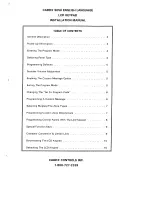
Macro Programming
What is a Macro?
A macro is a recording of a sequence of commands that is played back when the user presses a single button. A
macro can have up to 190 steps. A step can be:
IR Command -
Any IR command on any hard button, LCD button on any device. IR commands in the IR
Database are not available to Macros until they have been programmed into a button somewhere within
the configuration. Shortcuts cannot be used in macros.
Delay -
Adjustable delay between steps of .1 and 30 seconds. Longer delays can be created by using more
than one delay. If a delay is programmed as the first step in a Macro, the macro will not be issued until the
button is pressed and held for the specified amount of time.
Jump -
As the last step in a Macro, you can specify a jump to any page. Page jumps for the CK1.1 are
assigned using the CK1.1 LCD button editor. The jump will execute after any shortcut or macro that has
been programmed to that button.
What Buttons Can Playback a Macro?
Only the Main LCD buttons and can be programmed with a Macro on the CK1.1. However, any button can playback
a Macro by using a shortcut to a button that has a Macro in it.Thus, if you need a Macro on a hard button (i.e. CH-),
you can program the macro on an LCD button (could be in a hidden page somewhere) and simply shortcut to it.
Discrete IR Codes vs Toggle IR Codes
Manufacturers program their products to respond to IR codes with one action or many:
Toggle -
More than one action can occur when the code is sent by a keypad. An example is a POWER button.The
manufacturer programs the TV to respond to a POWER command by turning it on if it was off and
turning off if it was on. So one button can do two things. This requires that the user “know” or “see” that the
television is on or off before pressing the button.
Another example is a television with an “INPUT” command. When the code is issued, the television changes its
input. Since the television has 5 inputs, the single “INPUT” command can have five different results, depending on
what input was previously selected.The user has to “know” or “see” what input was previously selected before
deciding how many times to push the INPUT button.
Discrete -
Only one action can occur when the code is sent by a keypad. An example is a television with
a POWER ON button and a POWER OFF button. If the television is already on, the POWER ON command has no
effect. If the television is off, the POWER ON command will turn on the television. Another example is a television
with five discrete input commands (ANT A, ANT B, EXT 1, EXT 2 and EXT 3). No matter what input was previously
selected, any of these commands will change the television to the desired input WITHOUT the end user “knowing”
or “seeing” what the previously selected input was!
TIP - Not all components have “discrete”codes on their original remotes,check the IR Database!
.
26
Type in Section Title
S
B
I M P LY
E T T E R !
B K
&
U
S
I
N
G
C
K
E
D
I
T
O
R
T
O
P
R
O
G
R
A
M
Programming Tutorial















































